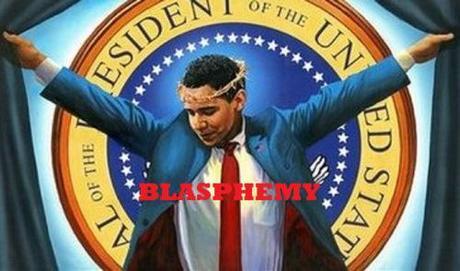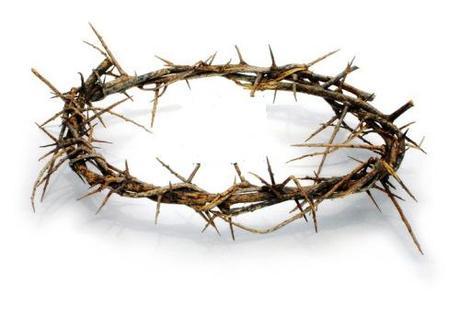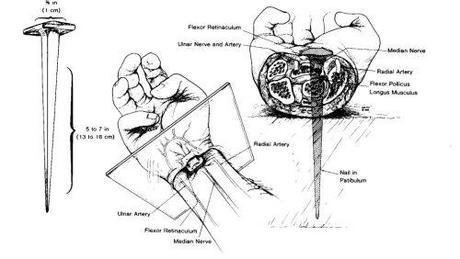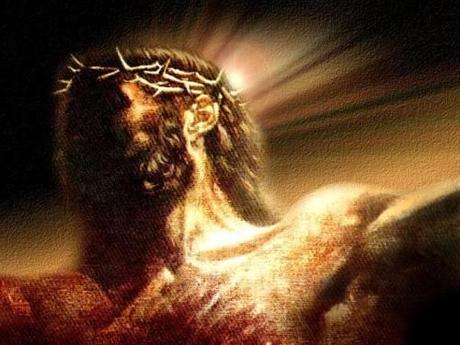Good Friday, April 18, 2014.
†
Though strong as an ox, my erstwhile friend, the faux socialist Stephanie, is allergic to work. She would take a temporary job and, when it ends, apply for unemployment benefits. When the benefits run out, she’ll go find another temp job. And so on…. She diagnosed herself as bipolar and got her therapist to sign her off as “depressive.” No doubt, she now collects Social Security Disability.
Though raised a Christian, Stephanie is a goddess cultist and wiccan witch. She is also rabidly anti-Christian. In a fit of self-pity, she once blurted to me: “Don’t tell me how Jesus had suffered. I’ve suffered more than Jesus!”

This post, “Remembering His Passion,” is for Stephanie, the “artist” Michael D’Antuono who painted the above blasphemous portrait of Obama in 2009, and all malignant narcissists who cheapen His memory by having the gall to compare themselves to Him.
 He sweated blood.
He sweated blood.

After He and his disciples had observed the Passover meal in an upper room in a home in southwest Jerusalem, they traveled to the Mount of Olives, northeast of the city.
There, in the garden of Gethsemane, for 12 hours (from 9 PM Thursday to 9 AM Friday), He prayed. He saw all the sins of humanity — past, present, and future — and knew that the time of His death was near. Suffering great mental anguish, He sweated blood (hematidrosis). As a result of hemorrhage into the sweat glands, His skin became fragile and tender. In the cold night air, His hematidrosis would have produced chills.
He was scourged at least 39 times.
Scourging or flogging was a legal preliminary to every Roman execution. The usual instrument was a short whip (flagellum) with several single or braided leather thongs of variable lengths, in which small iron balls or sharp pieces of sheep bones were tied at intervals. Occasionally, staves also were used.

As the Roman soldiers repeatedly struck His back with full force, the iron balls caused deep contusions, and the leather thongs and sheep bones cut into His skin and subcutaneous tissues.Then, as the flogging continued, the lacerations tore into His underlying skeletal muscles and produced quivering ribbons of bleeding flesh. Pain and blood loss set the stage for circulatory shock.
His scalp was pierced with thorns.
The Roman soldiers, amused that this weakened man had claimed to be a king, began to mock Him by placing a robe on his shoulders, a crown of thorns on His head, and a wooden staff as a scepter in His right hand. Next, they spat on Him and struck Him on the head with the wooden staff.
The crown of thorns was not a crown at all. It was probably a bush roughly applied, and tied on with rope.
The thorns probably came from the Lote Tree, a wild bush that still grows freely all over the Holy Land. This bush had thorns between one to two inches long. There are over 70 scalp wounds visible on the Shroud (of Turin).
The soldiers’ beating with the rods to His head covered with this crown would have caused severe bleeding. It is probable that the clump of thorns was removed before His tunic was put back onto His body, and then reapplied during the Crucifixion. The blood trickling down from the newly opened head wounds suggest that the thorns were reapplied before the Crucifixion.
Imagine the pain you’d feel if just one thorn, measuring 1 to 2 inches long, were stuck into your scalp.
He carried his own cross, weighing 125 lb.
The severe scourging, with its intense pain and appreciable blood loss, most probably left Him in a pre-shock state. Moreover, hematidrosis had rendered his skin particularly tender. The physical and mental abuse, as well as the lack of food, water, and sleep, also contributed to His generally weakened state. Therefore, even before the actual crucifixion, His physical condition was at least serious and possibly critical.
It was customary for the condemned man to carry his own cross from the flogging post to the site of crucifixion outside the city walls.
Since the weight of the entire cross was probably well over 300 lb., “only” the crossbar — weighing 75 to 125 lb. – was carried. The patibulum was placed across the nape of His neck and balanced along both shoulders, His outstretched arms tied to the crossbar. The processional to the site of crucifixion was led by a complete Roman military guard, headed by a centurion.
He was nailed to a cross to die
The Romans did not invent crucifixions, but they perfected it as a form of torture and capital punishment designed to produce a slow death with maximum pain and suffering. It was one of the most disgraceful and cruelest methods of execution and usually was reserved only for slaves, foreigners, revolutionaries, and the vilest of criminals.
At the site of execution, by law, He was given a bitter drink of wine mixed with myrrh (gall) as a mild analgesic. He was then thrown to the ground on his back, with his arms outstretched along the patibulum.
His hands were nailed to the crossbar at the wrists. The nails were tapered iron spikes approximately 5 to 7 inches long with a square shaft 3/8 in. across.

Every breath He took was a struggle, seared with pain.
The weight of His body, pulling down on the outstretched arms and shoulders, fixed the intercostal muscles in an inhalation state and thereby hinder passive exhalation. Accordingly, exhalation was primarily diaphragmatic, and breathing was shallow. This form of respiration would not suffice and hypercarbia (abnormally-elevated carbon dioxide levels in the blood) soon resulted. The onset of muscle cramps or tetanic contractions, due to fatigue and hypercarbia, further hindered His breathing.
To exhale, He had to lift His body by pushing up on His feet, flexing His elbows and adducting His shoulders. However, this maneuver placed the entire weight of the body on His tarsals, producing searing pain. Furthermore, flexion of His elbows caused rotation of His wrists about the iron nails, causing fiery pain along the damaged median nerves. Lifting of the body also painfully scraped His scourged back against the rough wooden stipes. Muscle cramps and paresthesias (pins and needles) of the outstretched and uplifted arms added to the discomfort. As a result, each respiratory effort became agonizing and tiring and led eventually to asphyxia (depletion of oxygen to the body).
After “only” 3 to 6 hours hung on the cross, He breathed his last.

He suffered terribly, unto death, for each one of us.
Remember His Passion today with the Stations of the Cross. Go here.
In memory of His love,
~Eowyn

